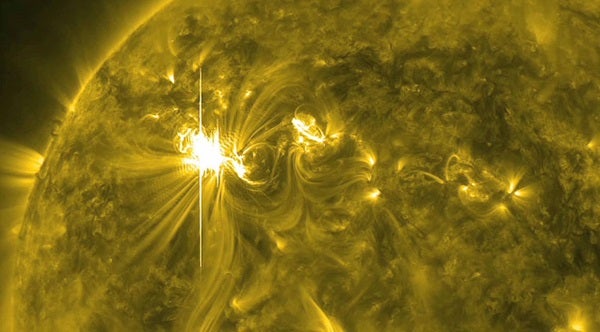The Sun erupted with one of the largest solar flares of this solar cycle March 6, 2012, at 7 p.m. EST. This flare was categorized as an X5.4, making it the second largest flare — after an X6.9 on August 9, 2011 — since the Sun’s activity segued into a period of relatively low activity called solar minimum in early 2007. The current increase in the number of X-class flares is part of the Sun’s normal 11-year solar cycle during which activity on the Sun ramps up to solar maximum, which is expected to peak in late 2013.
About an hour later, at 8:14 p.m. EST March 6, the same region let loose an X1.3 class flare. An X1 is five times smaller than an X5 flare.
These X-class flares erupted from an active region named AR 1429 that rotated into view March 2. Prior to this, the region had already produced numerous M-class and one X-class flare. The region continues to rotate across the front of the Sun, so the March 6 flare was more Earthward facing than the previous ones. It triggered a temporary radio blackout on the sunlit side of Earth that interfered with radio navigation and short wave radio.
In association with these flares, the Sun also expelled two significant CMEs, which are traveling faster than 600 miles (1,000 km) per second and may arrive at Earth in the next few days. In the meantime, the CME associated with the X-class flare from March 4 has dumped solar particles and magnetic fields into Earth’s atmosphere and distorted Earth’s magnetic fields, causing a moderate geomagnetic storm, rated a G2 on a scale from G1 to G5. Such storms happen when the magnetic fields around Earth rapidly change strength and shape. A moderate storm usually causes aurora and may interfere with high frequency radio transmission near the poles. This storm is already dwindling, but Earth may experience another enhancement if the most recent CMEs are directed toward and impact Earth.
In addition, the March 6 flares have sent solar particles into Earth’s atmosphere, producing a moderate solar energetic particle event, also called a solar radiation storm. NASA’s SOHO and STEREO spacecraft and NOAA’s GOES spacecraft have detected these particles. At the time of writing, this storm is rated an S3 on a scale that goes up to S5. Such storms can interfere with high frequency radio communication.
Besides the August 2011 X-class flare, the last time the Sun sent out flares of this magnitude was in 2006. There was an X6.5 on December 6, 2006, and an X9.0 on December 5, 2006. Like the most recent events, those two flares erupted from the same region on the Sun, which is a common occurrence.










